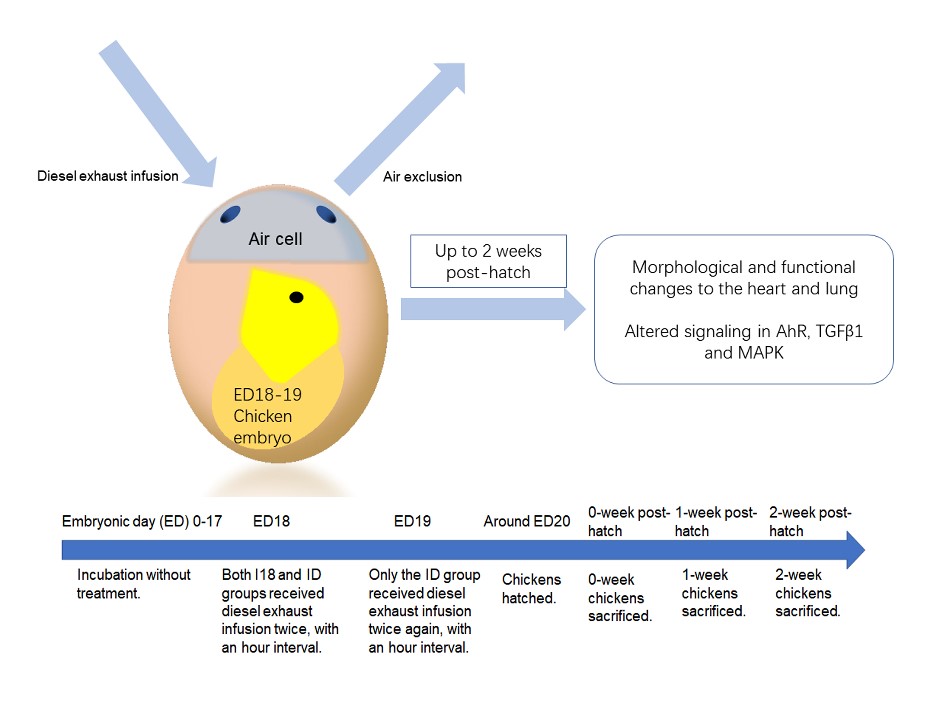The manuscript “In ovo very early-in-life exposure to diesel exhaust induced cardiopulmonary toxicity in a hatchling chick model” had been published on international scientific journal Environmental Pollution (Impact factor 5.714) by Dr. Qixiao Jiang (Ph.D., associate professor) and Dr. Yuxin Zheng (Ph.D., professor) from School of Public Health. In the manuscript, it had been discovered that
1. Chicken embryo may serve as an ideal model for diesel exhaust very early-in-life inhalation toxicity model
2. Persistent cardiopulmonary toxicities in hatchling chickens were observed following diesel exhaust very early-in-life inhalation exposure.
3. AhR/TGFβ1/MAPK signaling are associated with observed effects.
A novel inhalation model had been established, based on the unique characteristic of chicken embryo development, during which air inside the air-cell will be firstly inhaled when internal piping occured. With this model, the very early-in-life exposure towards “first breath in life” was achieved. Subsequent observations at 0-, 1-, and 2-weeks post hatch revealed persistent elevation of heart rate, thickening of right ventricular wall, enhanced expression of alpha-actin in pulmonary arterial wall and decreased cavity/vascular ratio, suggesting presence of cardiopulmonary toxicities. On the other hand, while no fibrosis were observed in 0-week animal myocardium or lung tissues, remarkable fibrotic changes were observed in both myocardium and lung tissues starting from 1-week post hatch and became more prominent at 2-week post hatch, suggesting that delayed fibrosis may be one of the toxicological endpoints following very early-in-life diesel exhaust exposure. Further mechanistic studies revealed that the classical AhR signaling was activated remarkably at 0-week time point but recovered over time. TGFβ1 signaling was also activated at 0-week and recovered by 1-week, but a suppression was observed at 2-week time point. Meanwhile, no significant changes were observed in MAPK signaling at 0- or 1-week, but elevated activation was observed at 2-week. These results suggested that different signaling molecules participated in different time points in the observed cardiopulmonary toxicities. This work indicated that neonatal exposure to diesel exhaust may affect cardiopulmonary health during childhood or even adulthood, thus provided evidence for better protection for human developmental cardiopulmonary health.

Dr. Qixiao Jiang is the first author of this manuscript and Dr. Yuxin Zheng is the corresponding author. This work is supported by National Natural Science Foundation of China (Grant No. 91643203, 91543208, 81872591).
姜启晓副教授与郑玉新教授发现柴油机尾气极早期暴露引起雏鸡心肺毒性效应及其机制
2020年5月3日,国际学术期刊Environmental Pollution (影响因子:5.714) 在线发表了我院姜启晓副教授与郑玉新教授题为“In ovo very early-in-life exposure to diesel exhaust induced cardiopulmonary toxicity in a hatchling chick model”的研究论文。该研究发现:
1. 鸡胚可作为理想的柴油机尾气极早期吸入模型。
2. 柴油机尾气极早期暴露在孵化后的雏鸡引起持久心肺毒性。
3. AhR/TGFβ1/MAPK信号为此心肺毒性主要相关机制。
该工作开创性地利用鸡胚发育中内啄壳(internal piping)时喙进入气室首先呼吸气室空气的特性,实现了针对“第一口气”的极早期染毒。之后分0,1,2周三个时间点观察,发现生命极早期尾气染毒引起了持续性的心率升高,右心壁增厚,肺小动脉壁alpha-actin表达增加,管腔比下降,提示出现心肺毒性。与此同时,虽然刚孵化的雏鸡心肺中未见纤维化改变,从1周起,心肌及肺脏中均出现明显纤维化改变,2周时更为显著,提示迟发性的纤维化改变损伤可能是极早期尾气暴露的毒性效应之一。进一步的机制研究发现,经典的AhR通路在0周时间点作用明显,此后逐渐消退。TGFβ1通路0周激活同样明显,但是1周时消退,2周时反而出现激活降低。而MAPK信号通路在0,1周时无明显改变,2周时强度明显升高,提示参与极早期尾气诱导心肺毒性的分子随着机体发育的进行有所改变。该工作提示尾气在新生儿的暴露可能对儿童以至成年后的心肺健康有相当的影响,为保护人类心肺发育健康提供了新的依据。

我院姜启晓副教授为论文的第一作者,郑玉新教授为该论文的通讯作者。该工作得到国家自然科学基金委重大研究计划“交通尾气颗粒物致健康损害效应的关键组分及人群生物标志物研究”的支持。
文章连接
https://doi.org/10.1016/j.envpol.2020.114718